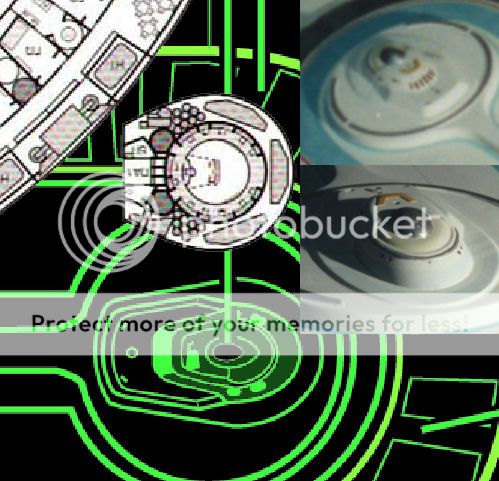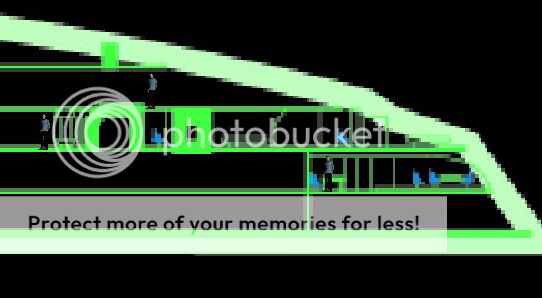Here is Jefferies’
(popular) pre-production sketch of the Enterprise. ... In terms of evolution the next step could be either to attach the warp engines to the secondary hull instead
(Enterprise)
[this is the one with the basic Jefferies Registry Scheme which he also confirmed in later interviews] or to relocate components of the secondary hull into the saucer and have the secondary hull reduced to a roll bar with sensor and/or torpedo pod
(Reliant).
Okay, I do better understand your rationale now. I'm afraid I still don't wholly agree. Yes, I do definitely see how Jefferies' concept art could be a primitive version of the
Oberth design - but if I'm understanding you correctly you're suggesting that some members of this design were converted into
Oberths and some were converted into
Mirandas?
Re-evaluating my original suggestion I think the pre-production sketches might have rather served first as a design inspiration for the
Reliant.
But please turn the Oberth picture (view from below angle, the one in the background just provided by
B.J. with some truly interesting details worth discussing) upside down.
Although the components differ in volume, it's obvious that if you were to make a CGI film depicting an evolution, it would be child's play to "morph" the
Grissom into
Reliant.
I now realize it's rather probable that an upside down
Reliant was the basic inspiration for the Oberth Class design from a production point of view.
But where does this leave us "in-universe"? Should the Oberth Class be a new design inspired by / that came
after the Miranda Class or would it better qualify as a pre-TOS design which inspired the (later) Miranda Class design (and possibly some others but unseen ones)?!?!
(I also think that the Daedalus Class would qualify better as a predecessor of the
Enterprise).

So perhaps, there was indeed a registry schema change at some point - and that change was to change from the JRS to a newer, simply sequential registry scheme, to fit with the fact that the production team similarly abandoned or ignored the JRS. So perhaps you're right - JRS until circa the 2280s, and then it all goes to hell.

Interesting how you put it, but - yes, that's essentially what I've been trying to convey.
Let's touch briefly on the JRS. Which ships are we presupposing fit to witch number? Going by what we have seen or what was spelled out on screen on TOS or the TOS films:
05 -
Revere type (TMP chatter)
06 -
Oberth (or whatever its earlier name may've been), includes Scout
U.S.S. Columbia (TMP chatter)
13 - Republic type ("United Star Ship"), maybe Baton Rouge Class?
16 - Constitution Class
17 -
Constitution aka Starship
17 - Enterprise aka Starship (already discussed in depth in 3 other threads in the past year, no need to do so again here, please!)
18 -
Miranda
20 -
Excelsior
21 -
Entente type (TMP chatter)
I still haven't found the corresponding TMP script excerpt 
Extrapolated from TNG, somewhat dubious:
19 -
Constellation (?) a can of Worms, "NX-1974" looks a little too conjectural, IMHO
19 - Soyuz (better fits the sibling character of 16/17 in an 18/19 context, IMHO)
25 -
Excelsior II (?)
(the one with bumpers)
28 -
Constellation (?)
(My annotations / suggestions in
italic and
bold)
I guess I just don't get why you feel so confident about Valiant.
Must be the flying saucer allusions I get from the Oberth's primary hull which could be an homage to either
Forbidden Planet or
Lost in Space.
Example: Where did the producers of "In A Mirror, Darkly" (ENT) get the "aft phaser" idea from. Well, for their Gorn study they obviously rewatched "Arena" which is the only other TOS episode (next to "A Private Little War") were "aft phaser/s" had been mentioned in the background chatter.
I can't exclude the possibility that while preparing the Valiant study model / Oberth prototype Nilo Rodis had been watching "A Taste of Armageddon" or "A Piece of the Action" (or was already familiar with the pre-TOS ship suggestions).
The
Horizon (or its primary hull) did land on Sigma Iotia, 100 years ahead of the Enterprise, the USS Valiant did make contact on Eminiar VII 50 years ahead of the Enterprise. So essentially, we are looking at a progression from a Federation starship that could land to one that's incapable of doing that and the Oberth flying saucer primary hull just looks like a credible missing link here.
Add to this the study model's name and that calculates 1+1=2, IMHO
Let us not forget that, for all their successes, the ILM modelmakers didn't even do the windows right on the Excelsior based on what size she was supposed to be - or the Oberth for that matter.
I shamefully admit that I missed class concerning the
Excelsior.
But on what exactly is the suggestion based that the "windows" on a 395'
Grissom do not have correct size?

Hm, would you then posit that in the pre-TOS 23rd century, vessel saucers made planetfall regularly, per the lines in TMoST? I could buy that, I think. It does nicely explain the penchant for saucer sections that Starfleet seems to have, and ties into "Forbidden Planet."
Yes, and it ties into FP.

The only question - and that might be something where I'm inclined to revise my original proposal - is how to give the Oberth Class primary hull landing legs. I said the ventral sphere of the saucer module looks like snap-in knob but that might just have been a deliberate intention designed to convey to us that it's a saucer module (the trick worked on me, obviously

).
In-universe the ventral sphere "knob" might not belong to the saucer module but to the warp sled and the bottom side of the saucer module is actually flat.
I guess, eventually it depends what function we assume the saucer rim embayments to have. Landing rocket thrusters?!?
We know why he picked 1701 - they were visually distinguishable. But I don't believe we have ever concretely proven when he came up with 17th, 1st. We know that it was stated to be an afterthought, but we don't know when. It's entirely possible he thought it up after "Court Martial."
Looking at Jefferies
Enterprise production sketch with the JRS annotation, I insist it is obvious that it's genuine TOS pre-production work:
- Enterprise is featured with baby bottle cap over main sensor (clearly a pre-production feature)
- Hangar doors are explicitly mentioned to have segments (rather redundant after these had been added onto the VFX model)
- "J" in Jefferies' signature is pre-TOS style "J" and not the one seen in his sketches from the 1970's
I assume Matt Jefferies didn't participate in the starship status chart (suggesting 97 starships of the 16th design). Maybe he pointed out it's wrong, but they didn't have the time or desire to fix it. Thus the meaning of the last two digits in JRS got a different meaning (changed premise) but there is no reason to assume that the meaning of the first two digits became automatically obsolete, too.
Therefore the first ship of a new class doesn't necessarily have to be "XX01". It can be "602", "2000" and for all we know NCC-1831 might have been the
Miranda (class ship).
I initially really don't like the idea of the Reliant pod containing the antimatter. That should mean that the antimatter has to go down into the ship, into the reactor, be processed, and go into the nacelles? It feels entirely too... complicated.
Does it really? Frankly, the one thing I never liked was the redress of
Enterprise's vertical intermix chamber coil as
the one of Reliant. The entire
Reliant design says "flat" or horizontal, in contrast to
Enterprise which invites vertical allusions.
(Apparently Nick Meyer preferred stunt people flying off the set, with the horizontal part of the set he wouldn't have achieved the same dramatic effect)
The interior explosion scene follows the phaser shots of the
Enterprise exclusively targeting the port nacelle
and pylon!
This immediately affects adjacent internal components and the vertical intermix chamber seen on screen is obviously in this vicinity, and thus compliant with the concept that antimatter might be channeled down from the pod to a port (and starboard)side intermix chamber!


Regarding the antimatter itself, I assume that it is taken for granted that flying faster than light in a ship contains inherent dangers, akin to flying in a modern aircraft in the real world. We should remember to take that into account - no ship is "boom" proof.
I'd like to use your example for a reply I still owe
Timo.
If you sign up for the dangerous trip into space and you perish there, it's your own risk and responsibility as it apparently happened with the
Horizon and the
Essex.
Riding on a volatile antimatter pod (bomb) was the choice of the astronauts voluntarily doing so and accepting the risk.
But to have such a thing accidentally detonate in the atmosphere of an alien civilization you visit (uninvited) to engage First Contact and open relations, would have rather constituted an act of war.
Hence, the separation of the ship's landing module and the parking of the secondary hull containing the antimatter in a stable orbit, was objectively a mandatory option to achieve your First Contact goal in these pre-TOS days of the
Horizon and - possibly - the
Valiant.
Bob
(I hope to catch up with the other posts later as I'm currently involved in way too many threads that take up too much time. Of course, I can only blame myself

)




 ). Apparently both torpedos and antimatter fuel may have been depleted at this time (but Enterprise was unaware of it).
). Apparently both torpedos and antimatter fuel may have been depleted at this time (but Enterprise was unaware of it).


 Interesting how you put it, but - yes, that's essentially what I've been trying to convey.
Interesting how you put it, but - yes, that's essentially what I've been trying to convey.





 - is a study model for a supposedly late 23rd Century design (for ST III).
- is a study model for a supposedly late 23rd Century design (for ST III). )
)